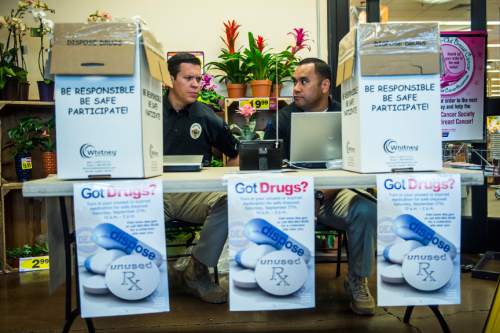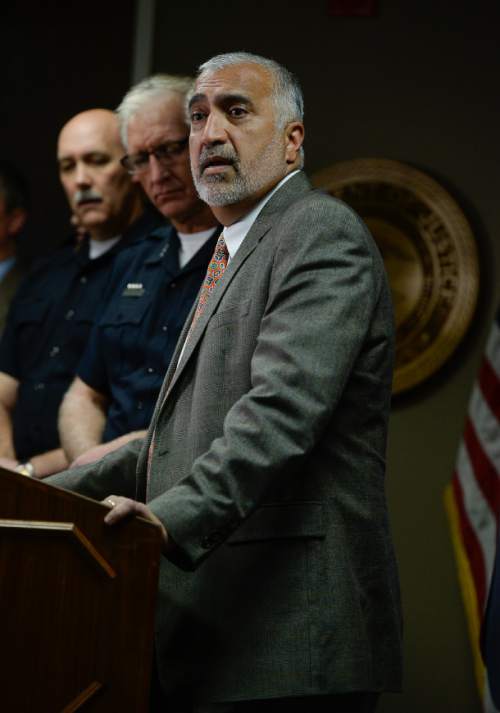This is an archived article that was published on sltrib.com in 2016, and information in the article may be outdated. It is provided only for personal research purposes and may not be reprinted.
Two hundred Unified Police Department officers will get anti-overdose kits and training to use them upon encountering a person dying from heroin or opioid use.
"Since law enforcement plays an important role as first responders in emergencies, we want to equip them with the necessary tools to save lives," said Salt Lake County District Attorney Sim Gill, who will provide funding for UPD officers to receive naloxone rescue kits.
Gill offered to underwrite the prevention effort during a recent four-hour session when the Salt Lake County Council received a briefing on the "opioid crisis" increasingly engulfing the valley.
"The impact of opioids is pervasive, prevalent and epidemic. It affects every one of us," said Republican Councilman Steve DeBry, who has first-hand experience with the problem from running UPD operations in Millcreek.
Added Democratic Councilwoman Jenny Wilson: "I am incredibly touched by the enormity of the problem, but also inspired to work toward solutions, to do more with the funds we have and identify other resources." She co-sponsored the discussion with DeBry in a show of bipartisanship.
Gill identified his office's asset-forfeiture fund as a source of money to buy anti-overdose kits for the UPD.
"It's an important thing every officer should have," he said. "When we talk about the lives we can be saving, it's a no brainer."
Council members heard mountains of evidence from state and county health department officials about the changing but steadily increasing nature of the county's drug problem.
Anna Fondario, who runs the state health department's violence- and injury-prevention program, said Utah had the fourth-highest rate of drug-overdose deaths in the country between 2002 and 2014.
Heroin and other opioids have overtaken automobile crashes as the leading cause of accidental deaths in the state. A huge increase in the number of deaths related to methamphetamine use also is "something we want to make sure we address," Fondario added.
Opioids have been blamed for 483 deaths in Salt Lake County in that 12-year span, said Gary Edwards, health department executive director.
A statistical analysis of those fatalities showed just how widespread the problem is.
Almost 40 percent of the victims are female. High death rates occurred among people 45 to 54 years old. Twenty percent of the victims had more than a high school education, said Edwards and health department colleague Seth Whittle.
While the problem is particularly acute among the homeless population in downtown Salt Lake City, Edwards said there are also several "hot spots" in suburbs.
A map he used showed a hot spot in West Valley City, three more in neighborhoods southeast of the southern intersection of Interstate 15 and I-215, and a fifth in the South Jordan-West Jordan area.
"People from all walks of life are experiencing this epidemic," Whittle said.
While equipping UPD officers with naloxone kits is expected to save lives in the short term, Fondario and state substance-abuse official Brent Kelsey said the battle is being waged on several fronts to make a long-term impact.
Education campaigns are underway to emphasize the extent of the epidemic, including the publication of 90,000 pocket cards to help people recognize overdoses, Fondario said.
A needle-exchange program appears to be helping to minimize accidents involving dirty injections. Clinical guidelines are being revised for prescribing opioids and additional training will be provided for prescribers, she added.
A fatality review team also is being assembled to study opioid-related deaths — particularly those involving heroin — to help investigators understand the progression of drug use that ended a victim's life.
Throughout this discussion, Gill and Wilson emphasized that legislative approval of full Medicaid expansion would have provided the badly needed dollars to conduct this fight.
Wilson said she doesn't believe legislators opposed to Medicaid expansion understand "how devastating this epidemic is in the community." Such funding, she added, "is what we need to create a safer community and save lives."
Naloxone kits
P Naloxone is a drug used for more than four decades to counteract opiate-drug overdoses in an emergency. The kits include injectable or inhalable naloxone, alcohol pads, rubber gloves, rescue breathing masks and written material to help the provider administer it correctly. —
Prescription opioid deaths
The prescribed opiates responsible for the most deaths in Salt Lake County between 2002 and 2014 were:
Oxycodone • 37 percent
Morphine • 18 percent
Methadone • 15 percent
Hydrocodone • 14 percent
Codeine • 6 percent
Fentanyl • 3 percent
Others • 4 percent
Source: Salt Lake County Health Department





